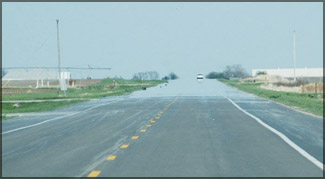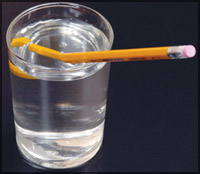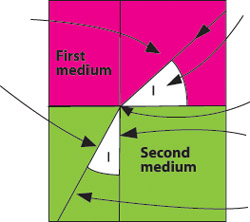Refraction of light waves
 Light
travels at different speeds through different materials. It travels at
3x108 m/sec in a vacuum, at a Light
travels at different speeds through different materials. It travels at
3x108 m/sec in a vacuum, at a
|

A mirage |
slightly lower speed through air, and at 2x108 m/sec through
glass. In a diamond, light travels at about 40 per cent of its speed in
a vacuum.
When light goes from one medium to another, its speed changes.
Because of this, the light rays bend. The process of light bending when
passing from one medium to another is known as
refraction. A transparent
substance in which light travels is known as a
medium. Air, glass, water, ice
and diamond are examples of such media.
Different media are said to have different optical densities. A
medium in which the speed of light is more when compared with another
medium is known as an optically rarer medium. Air is an optically rarer
medium as compared to water or glass.
A medium in which the speed of light is less when compared with
another medium is known as an optically denser medium. Glass is
optically denser than air and water. When a ray of light goes from a
rarer medium to a denser medium, it bends towards the normal (at the
point of incidence). When a ray of light goes from a denser
|

Light bending when travelling between different media |
medium to a rarer medium, it bends away from the normal (at the point
of incidence).
Consider the pane of thick window glass as shown in the picture
(Figure A). When light falls normally to the surface of a glass slab
(from point A through the glass to point B), it will go in a straight
path. In this case, light encounters the glass perpendicularly (at a 90
degree angle) and hence there is no bending of the ray of light.
However, when it goes from A to C, the emerging light is displaced,
but parallel to the incident light. A ray of light (Aa) travelling in
air is directed on the glass block. On entering the glass block, it is
refracted and bends towards the normal.
Again, a change of direction takes place when the ray of light (ac),
travelling in glass emerges into the air at point c. Since the ray of
light (ac) goes from a denser medium (glass) into the rarer medium
(air), it bends away from the normal and goes in the direction cC. The
incident ray (the ray which hits the medium)/Aa and the emergent ray/cC
are parallel to each other.
How a road mirage is formed
You may have seen a pool of water lying on the road some distance
ahead of you on a sunny day. Were you ever able to reach it? No, you could always see it at some distance.
ever able to reach it? No, you could always see it at some distance.
This incident can also be explained through the concept of
refraction. The water you see on the road is a mirage formed by light
rays coming from the low section of the sky in front of you.
The air is very hot just above the road surface and cooler above.
Light travels faster through the thinner hot air than through the denser
cool air above it. As the rays of light descend, instead of coming to us
from the sky in straight lines, they continuously bend towards the
horizontal.
Light from the sky picks up speed in air near the ground because that
air is warmer and less dense than the air above. When the light grazes
the surface and bends upward, the observer sees a mirage. A mirage is
not, as many people mistakenly believe, a 'trick of the mind'.
Refraction occurs when the average speed of light changes in going
from one transparent medium to another. Consider a pair of wheels
connected to an axle. As the wheels roll gently down from a smooth
sidewalk onto a grass lawn, the wheels meet the grass at some angle;
they will be deflected from their straight-line course.
 On
meeting the lawn, the wheels roll more slowly due to interaction with
the grass and the left wheel slows down first. This is because it meets
the grass first while the right wheel is still on the sidewalk. The
faster-moving right wheel tends to pivot above the slower-moving left
wheel because during the same time interval, the right wheel travels
farther than the left one. This action bends the direction of the
rolling wheels toward the "normal". On
meeting the lawn, the wheels roll more slowly due to interaction with
the grass and the left wheel slows down first. This is because it meets
the grass first while the right wheel is still on the sidewalk. The
faster-moving right wheel tends to pivot above the slower-moving left
wheel because during the same time interval, the right wheel travels
farther than the left one. This action bends the direction of the
rolling wheels toward the "normal".
A light wave bends in a similar way. Thus, the phenomenon(occurrence
that appears) of a mirage can be drawn when light rays are refracted as
they pass from air layers that are less dense to more dense air.
The refraction of light is a very complicated subject and there's a
lot more to write about it. We'll bring you more details on refraction
in our next The World of Science page.
Compiled by Janani Amarasekara |
